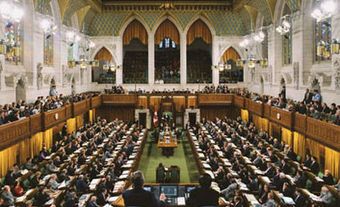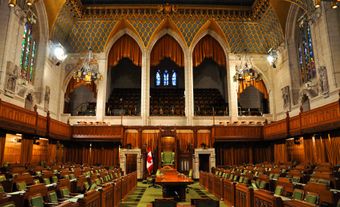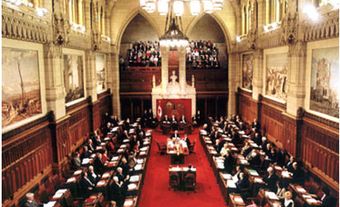In Canada’s parliamentary system of government, the cabinet is the committee of ministers that holds executive power. Cabinets are chaired by the prime minister (or in the provinces, by the premier). Ministers are typically elected politicians drawn from the party holding the most seats in the House of Commons (or the provincial legislature). Cabinets are traditionally strong, consensus-driven bodies; although some believe their influence is waning in the face of powerful prime ministers and their advisers.

How Cabinets Work
The cabinet is also known as “government-of-the-day.” It has been described as the “hyphen which joins [or] the buckle which fastens the legislative part of the state to the executive part of the state.” It is responsible for the introduction and passage of legislation; the execution and administration of public policies and priorities; and the finances of the government. For a body of such obvious power and influence, it has no specific constitutional or statutory basis.
In Canada, the federal Cabinet derives its legal powers from the Privy Council and acts in the name of the Crown. Its political capacity to govern depends upon its ability to secure and maintain majority support in the House of Commons. Legislation and regulations are given the force of law through an Order-in-Council of the Governor General, acting on the advice of the Privy Council (in practice, the Cabinet). Provincial cabinets are known formally as executive councils. They follow the federal model except in certain powers of appointment.
The federal Cabinet consists of Members of Parliament (MPs). They are appointed by the prime minister to head major government departments. With the expansion of government activity, cabinets have increased in size from the original 12 to a high of 40 members (under Prime Minister Brian Mulroney in September 1987). Downsizing reforms somewhat reversed this growth. (Prime Minister Jean Chrétien’s Cabinet in January 1996 had 25 members.) However, in July 2013, Prime Minister Stephen Harper led a Cabinet of 39 members.
Cabinet Committee System
It has been the practice in Canada to include all ministers in the federal Cabinet. As a result, the Cabinet has grown to an unwieldy size. A secretariat and an elaborate committee system have been developed in response. The secretariat for Cabinet and its committees is provided mainly by the Privy Council Office. The Treasury Board is the only Cabinet committee created by Parliament. An unusual feature of Cabinet committees in Canada is that senior nonelected public servants participate; although they are excluded from Cabinet meetings.
Recent decades have witnessed various attempts to address the problem of an unwieldy Cabinet. Prime Minister Pierre Trudeau relied on various coordinating committees. These were headed by a Policies and Priorities Committee, which he chaired. Trudeau’s Conservative successors favoured an “inner Cabinet.” It performed the same task of establishing government priorities and setting spending limits. Following the British model, various “junior ministers” are now appointed to assist more senior Cabinet ministers and to complete the ministry. The junior ministers are also called Secretaries of State.
How Cabinets Are Made
Choosing a cabinet in Canada requires considerable artfulness on the part of the prime minister. He or she must try to ensure that it represents the country’s regional, linguistic and ethnic diversity. When a victorious party fails to elect MPs in certain regions, a prime minister often resorts to the Senate to fill out the Cabinet. The number of women in Cabinet, the number of francophones, and a role for Indigenous politicians and members of other minority groups, are all important considerations.
Cabinet-making has also traditionally been an exercise in power politics. Influential and important figures within the governing party are awarded prominent roles in the cabinet. In this way, the prime minister seeks to maintain power by sharing it; they also seek consensus rather than confrontation with their internal party rivals.
Secrecy
All members of Cabinet are bound for life by the Privy Council oath of secrecy. It protects cabinet deliberations and organization. Opinions publicly expressed by a minister are those of cabinet. Ministers may disagree publicly with those opinions only after resigning from cabinet. They then must not reveal details of cabinet discussions or documents.
The Official Secrets Act prohibits all Canadians — but particularly public employees, opposition critics and investigating journalists — from possessing, distributing and publicizing information deemed injurious to the state. The Act has also been used to protect cabinet members. In order to avoid embarrassment, they can choose to portray themselves as privy councillors to the Crown rather than as a government responsible to the House of Commons. They can thereby decline to answer certain questions. The secrecy surrounding cabinet business is defended on the grounds that it is necessary for maintaining cabinet solidarity; without it, a cabinet may lose its hold over the legislature and therefore its right to govern.

Cabinet Power on the Rise
To dominate the legislature, a cabinet can rely as well on its control over the governing party. Parliamentary government is party government. (See Canadian Party System.) Prime ministers have substantial patronage at their disposal to ensure party loyalty. This patronage includes appointment of cabinet ministers and parliamentary secretaries and of chairmen of legislative committees. In fact, the control exerted by Cabinet over the House of Commons through the levers of party discipline has contributed, since the late 1970s, to an outcry against Cabinet power.
The traditional capacity of the legislature to bring down the government and therefore the Cabinet through a non-confidence vote appears to be losing force. This is largely because the Cabinet has the power, through its legislative party majority, to prevent such votes; or at worst, to refuse to accept their implications or consequences. Yet the legislature’s ability to hold the executive accountable underpins the whole notion of responsible government, upon which Canada’s democracy is based.
The imbalance between the House of Commons and the Cabinet is made worse by the increasing use of discretionary powers in a wide variety of government business. This allows the executive to legislate by order-in-council or by ministerial order. This development began in the Trudeau years and gained strength through successive regimes. It accounts for the growing belief that Cabinets have become too powerful. This is particularly true when it is added to the Cabinet's traditional roles of initiating the budget; ensuring its safe passage; and preparing and introducing all major legislative proposals.
A large reason for such changes is the growing size and complexity of modern government. The bureaucratic infrastructure for which ministers are expected to be accountable has become enormous. As a result, the idea of ministerial responsibility — ministers being personally responsible for every facet of the departments they oversee — has come to be seen as unreasonable. As a result, some of that accountability is now passed on to powerful, nonelected public servants; they do not sit in the Commons and can therefore not be held responsible by its members. Any reforms designed to hold the Cabinet accountable will also have to address this related problem.
Recent reforms to alter the imbalance between Cabinet and Parliament have included increasing the capacity of Commons committees to monitor government activity; Freedom of Information laws; and the creation in 2006 of the Parliamentary Budget Office (PBO). The purpose of the PBO is to examine and provide information to Parliament on government spending. In 2013, the future of the PBO was in doubt. This followed several years of bitter conflict with the Cabinet over the PBO’s right to financial information.
Cabinet Power in Decline
Most recently, fears of Cabinet domination have given way to concern that the Cabinet itself has become too heavily controlled by the prime minister and his nonelected advisers (who in turn dominate Parliament). Author and scholar Donald Savoie has reported that since the governments of Pierre Trudeau, the Cabinet is less a decision-making body and more a “focus group.” Policies, priorities and spending plans are made in the Prime Minister’s Office (PMO) by the leader and his political staff; sometimes with the help of one or two powerful, trusted Cabinet lieutenants. They are then handed down at Cabinet meetings for rubber-stamping. Savoie and other critics say this trend gained momentum under the Mulroney, Chrétien and Harper cabinets. In the Harper government, many ministers and their staffs could not speak to the media, or make public pronouncements, without having such communication cleared first by the PMO.
In August 2007, Harper responded to criticism that too much power was concentrated in his hands, at the expense of Cabinet. “On very, very rare occasions would I make a decision on a policy matter — as opposed to just routine, machinery of government issues — would I make a decision on a policy matter unilaterally,” he told reporters. “On all but a very small number of issues, there’s been a very, very broad consensus in our Cabinet. I don’t think I’ve ever been in a position where I’ve had to really force a decision through on one group of people or another.”
The relationship between Cabinet and the PMO also came under scrutiny in the Liberal government under Justin Trudeau; particularly during the SNC-Lavalin affair. In February 2019, Minister of Justice and Attorney General Jody Wilson-Raybould and Minister of Indigenous Services Jane Philpott resigned from Cabinet due to the government’s handling of this case. According to Wilson-Raybould, the PMO and other staff had pressured her to intervene in a federal case against SNC-Lavalin, directing federal prosecutors to negotiate a deal with the company. Ethics Commissioner Mario Dion found that Trudeau had improperly attempted to influence Wilson-Raybould and had breached conflict of interest law.
Current Federal Cabinet
|
Ministry |
Minister |
Constituency |
|
|
Papineau, QC |
|||
|
Finance and Intergovernmental Affairs |
Beauséjour, QC |
||
|
Transport and Internal Trade |
Anita Anand |
Oakville, ON |
|
|
Crown Indigenous Relations and Northern Affairs and the Canadian Northern Economic Development Agency |
Gary Anandasangaree |
Scarborough—Rouge Park, ON |
|
|
Citizens’ Services |
Terry Beech |
Burnaby North—Seymour, BC |
|
|
Élisabeth Brière |
Sherbrooke, QC |
||
|
Bill Blair |
Scarborough Southwest, ON |
||
|
Housing, Infrastructure and Communities |
Nate Erskine-Smith |
Beaches—East York, ON |
|
|
Innovation, Science and Industry |
François-Philippe Champagne |
Mississauga–Malton, ON |
|
|
Public Services and Procurement and Quebec Lieutenant |
Jean-Yves Duclos |
Québec, QC |
|
|
Official Languages and Associate Minister of Public Safety |
Rachel Bendayan |
Outremont, QC |
|
|
Leader of the Government in the House of Commons |
Karina Gould |
Burlington, ON |
|
|
Environment and Climate Change |
Laurier—Sainte-Marie, QC |
||
|
Indigenous Services and the Federal Economic Development Agency for Northern Ontario |
Patty Hajdu |
Thunder Bay—Superior North, ON |
|
|
Mark Holland |
Ajax, ON |
||
|
Ahmed Hussen |
York South—Weston, ON |
||
|
Rural Economic Development and the Atlantic Canada Opportunities Agency |
Gudie Hutchings |
Long Range Mountains, NL |
|
|
Women and Gender Equality and Youth |
Marci Ien |
Toronto Centre, ON |
|
|
Mélanie Joly |
Ahuntsic-Cartierville, QC |
||
|
Diversity, Inclusion and Persons with Disabilities |
Kamal Khera |
Brampton West, ON |
|
|
Employment, Workforce Development and Labour |
Steven MacKinnon |
Gatineau, QC |
|
|
Fisheries, Oceans and the Canadian Coast Guard |
Diane Lebouthillier |
Gaspésie—Les Îles-de-la-Madeleine, QC |
|
|
Agriculture and Agri-Food |
Lawrence MacAulay |
Cardigan, PEI |
|
|
Tourism and the Economic Development Agency of Canada for the Regions of Quebec |
Soraya Martinez Ferrada |
Hochelaga, QC |
|
|
Immigration, Refugees and Citizenship |
Marc Miller |
Ville-Marie—Le Sud-Ouest—Île-des-Sœurs, QC |
|
|
Export Promotion, International Trade and Economic Development |
Mary Ng |
Markham–Thornhill, ON |
|
|
Public Safety |
David J. McGuinty |
Ottawa South, ON |
|
|
Veterans Affairs and Associate Minister of National Defence |
Darren Fisher |
Dartmouth—Cole Harbour, NS |
|
|
Democratic Institutions and the Federal Economic Development Agency for Southern Ontario |
Ruby Sahota |
Brampton North, ON |
|
|
Treasury Board President |
Ginette Petitpas Taylor |
Moncton—Riverview—Dieppe, NB |
|
|
Emergency Preparedness, Pacific Economic Development Agency, and President of the King’s Privy Council for Canada |
Vancouver South, BC |
||
|
Canadian Heritage |
Pascale St-Onge |
Brome—Missisquoi, QC |
|
|
Families, Children and Social Development |
Jenna Sudds |
Kanata—Carleton, ON |
|
|
Seniors |
Joanne Thompson |
St. John’s East, NL |
|
|
Small Business |
Rechie Valdez |
Mississauga—Streetsville, ON |
|
|
Sport and Prairies Economic Development Canada |
Terry Duguid |
Winnipeg South, MB |
|
|
Justice and Attorney General of Canada |
Arif Virani |
Parkdale—High Park, ON |
|
|
Energy and Natural Resources |
Jonathan Wilkinson |
North Vancouver, BC |
|
|
Mental Health and Addictions, Associate Minister of Health |
Ya’ara Saks |
York Centre, ON |
|

 Share on Facebook
Share on Facebook Share on X
Share on X Share by Email
Share by Email Share on Google Classroom
Share on Google Classroom




